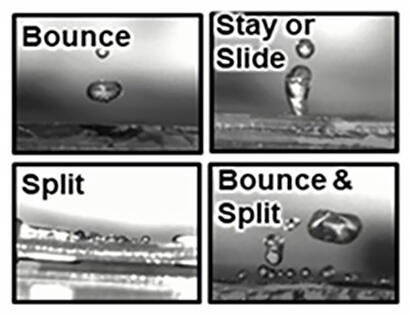A research group led by Professor Kuniharu Takei of the Graduate School of Engineering, Osaka Metropolitan University, and Associate Professor Kohei Nakajima of the Graduate School of Information Science and Technology, the University of Tokyo, has succeeded in developing a sensor that can instantly and simultaneously measure precipitation and wind speed by measuring the electrical resistance generated when water droplets hit the sensor's surface, using machine learning "reservoir computing" analysis.
Realizing a system that can constantly map torrential rainstorm information in real time can lead to safer, more secure and more comfortable lives. The research group sought to construct a sensor system that simultaneously and simply measures precipitation and wind speed, which are important information for torrential rainstorms.
In this research they developed a flexible rain and wind sensor using multilayer graphene that can be formed by laser irradiation of polyimide film to detect the state of water droplets. The sensor measures the behavior of water droplets in real time and analyzes it using reservoir computing to predict the volume of water droplets and wind speed. To control the behavior of water droplets when they hit the sensor surface, the sensor uses silicone rubber (PDMS) infused with graphene and is further processed with a laser. Furthermore, by changing the surface conditions, it was evident in high-speed photographs that the water droplets bounce or split on the sensor surface. By effectively using the behavior of the water droplets, they measured the conductance (inverse of resistance) of the water in real time to predict the volume and impact velocity of the droplets.
The PDMS used in the developed sensor is flexible, so the sensor itself can be bent and stretched, allowing it to be attached to umbrellas, roofs, automobiles and other objects. Sensors were attached to umbrellas to measure and analyze natural wind and artificially-generated random water droplets. The results showed that wind speed could be measured with commercial sensors without significant error. The wind speed results and water droplet volume prediction results also revealed that the volume of water droplets could be predicted to some extent.

Provided by Osaka Metropolitan University
"Moving forward, we would like to increase the accuracy of the sensor and expand it to large-scale testing for practical use," says Professor Takei. "This sensor system concept can be used not only for forecasting rain and wind, but also as a method to obtain multiple outputs from a film-type sensor sheet. This will greatly contribute to low power consumption and simplified systems in the next-generation IoT society, and we hope to expand the application of this technology to various fields."
Journal Information
Publication: Advanced Materials
Title: A Multi-Tasking Flexible Sensor via Reservoir Computing
DOI: 10.1002/adma.202201663
This article has been translated by JST with permission from The Science News Ltd.(https://sci-news.co.jp/). Unauthorized reproduction of the article and photographs is prohibited.




